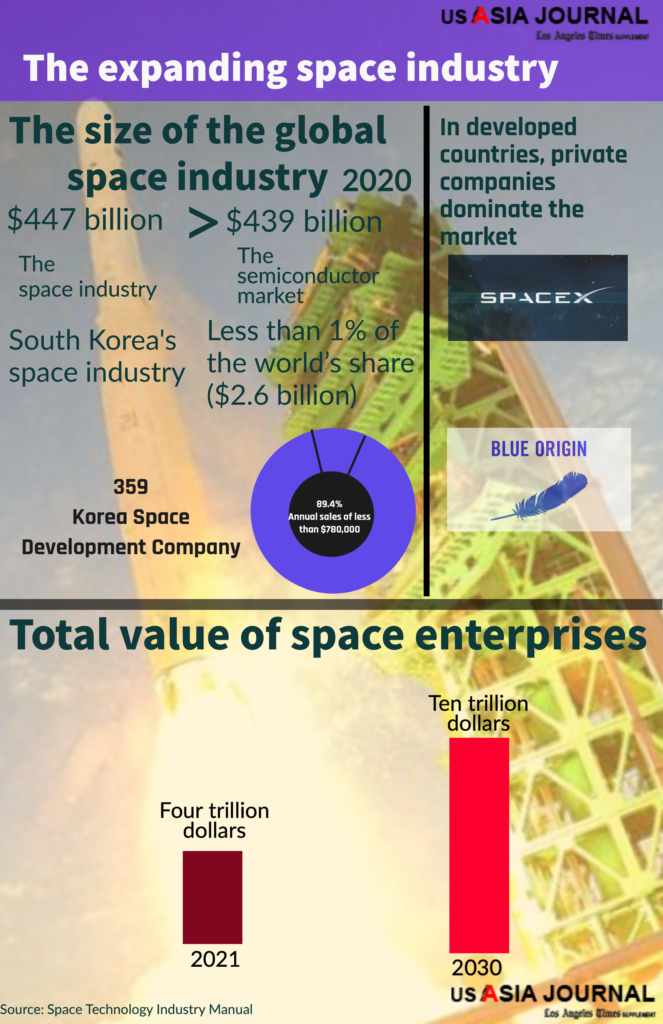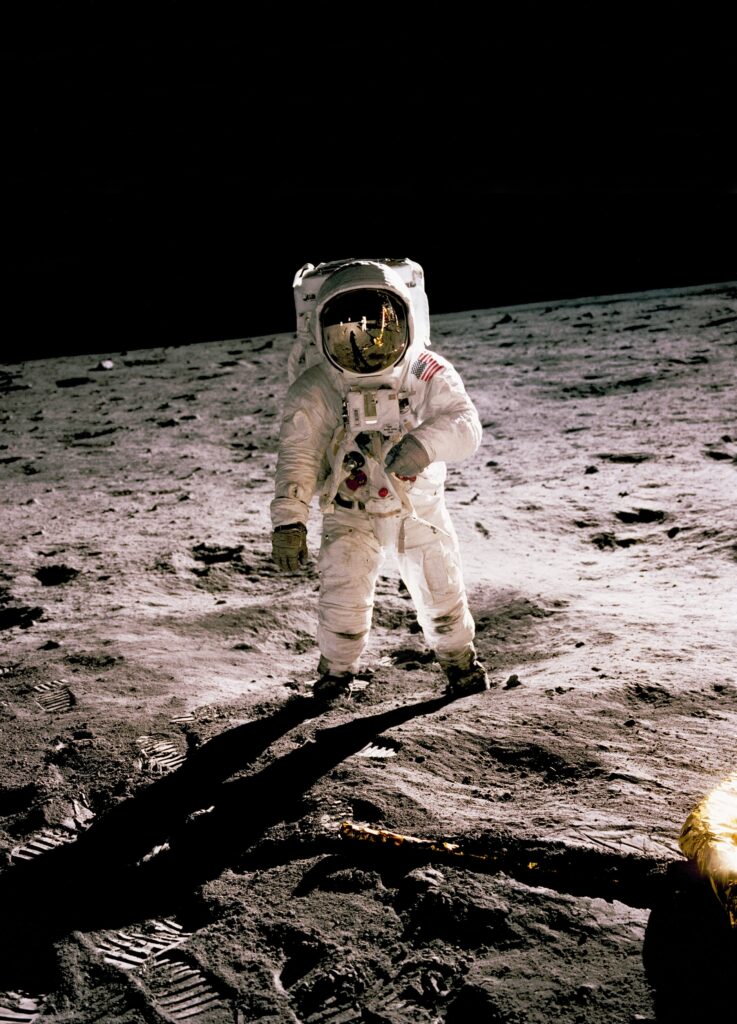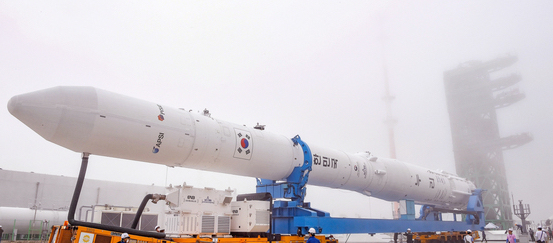
The global space industry is growing rapidly, with the size of the space industry rising 4.4% year-on-year to $447 billion in 2020. Considering that the global semiconductor market is about $439 billion in 2020, it is easier to understand the size of the space industry, its impact on the national economy, and its growth potential.
This is because space development in the private sector is increasing and investment and finance in space startups are increasing. Therefore, countries around the world continue to make policies and investments to promote space development as a key policy and foster it as a key engine for future national growth. The United States is taking the lead in fostering the space industry to secure future national interests. China, Japan, the United Kingdom, and Australia are also increasing their space-related budgets and strengthening policies to foster the space industry.
As promising space industries in the future, ultra-small satellites, numerous satellite big data services produced by satellites, and businesses for launching ultra-small satellites are promising. SpaceX and Blue Origin started as startups and have grown into global space companies leading the space market today. According to the Guide to the Space Technology Industry, the total value of space companies around the world has exceeded $4 trillion and is expected to reach $10 trillion by 2030.
Space development has a widespread impact on all industries, and in the case of broadcasting and communication industries through satellites, new industries are created through the development and production of TVs, cell phones, semiconductors, satellite receiving devices, and GPS receiversMitsubishi Heavy Industries is the company that Japan has put forward as a representative player to grow the space industry. I have been to the Nagoya rocket factory, which makes H-2A rockets, Japan’s flagship rocket, which is rarely disclosed to foreigners. H is an English alphabet referring to hydrogen, which means liquid hydrogen as fuel for rockets. Liquid hydrogen is a high-level technology that can easily explode with a little mishandling, and only spacecraft advanced countries use it, while South Korea uses kerosene, or kerosene-fueled rockets, such as Russia and the U.S. SpaceX. Even if kerosene is used as fuel, there is no problem at all in generating rocket power and propulsion.During a visit to a Japanese rocket factory, Shoichiro Asada, head of the rocket department in Mitsubishi, once asked, “How did the state-led space industry become led by private companies such as Mitsubishi?” Since space development costs a lot of money in the early stages, space development was led by the state and failed in many cases, but since it was led by the state, the budget continues to be invested to build the foundation for space technology. If the rocket’s technology is confirmed to be satisfactory, it will make money by transferring state-led space development to the private sector to industrialize space development and develop it into a lucrative industryThe Japanese government gave Mitsubishi a precondition that it should launch at least three satellites a year, but two of them should be ordered by the government and the other should be paid to launch foreign satellites instead. Therefore, in 2012, Arirang-3 satellite was put into low orbit by a Japanese rocket at a dumping price of 12 billion won cheaper than Russia, which was a competitor for launch costs. This is the first time in Japanese history that a foreign satellite was launched on behalf of a foreign satellite for money. Our money spent on satellite launches falls in Japan.
Japan, which has its own rocket, can launch its own satellites at any time, including weather satellites, military intelligence satellites, GPS satellites, and asteroid exploration satellites, so it does not have to carry them into French Aryan rockets and pay as much as 70 billion won. It is a sad reality in Korea without its own rocket. So we have to push ahead with the space industry quickly.
The space industry has grown in three stages over the past 60 years. The first stage was the product of the Cold War era, in which the U.S. and the U.S. competed for space development with the success of the Soviet Sputnik rocket.
The second was the time when the purpose of space development began to diversify with the Apollo 11 moon landing in 1969. The third stage refers to the time when practical satellite services such as broadcasting satellites, communication satellites, weather satellites, and navigation satellites were used as important infrastructure for the nation as well as daily life. In future space development, the “commercialization” of the universe will advance faster, with private companies entering space development, and the movement to secure economic benefits and national interests through space development such as space exploration and securing space resources will be stronger.
In Korea, the number of companies participating in the space industry is gradually increasing in the process of developing the cruise rocket Nuri, which is scheduled to be delayed several times due to the weather on the 21st. Among them, Hanwha Aerospace was in charge of engine assembly, turbo pump production, and engine test facilities for Nuri rocket, and Hyundai Heavy Industries built a second launch pad for Nuri launch based on its experience when it launched Nuri in cooperation with Russia. Hyundai Rotem also participated in the construction of test facilities for propulsion institutions, and the pairing, a satellite protection cover, was made by Huiba Korea.The Korea Aerospace Industries (KAI) is also in charge of building the Nuri rocket, a three-stage rocket, and is currently speeding up the era of private satellite development by leading the development of the next-generation mid-range satellite 2. Small satellites have also been exported by Setrek Eye, and as Hanwha Aerospace acquired them and the era of small satellites is coming, the future of this field is hopeful, but the space industry is generally small.

Compared to the rapid movement of spacecraft development countries, Korea’s space development is significantly lacking compared to spacecraft development countries in terms of organization, manpower, and budget. The size of the domestic space industry is 3.261 trillion won as of 2020, which is only 1% of the global space industry. The market structure of the domestic space industry is very weak, and it is difficult to find market competition between companies due to the R&D-oriented market structure. There are a total of 359 space development companies, of which 321 are (89.4%) are small and medium-sized companies and 227 (63.2%) account for less than 1 billion won in annual sales.
KilSeng Choi
ASIA JOURNAL




